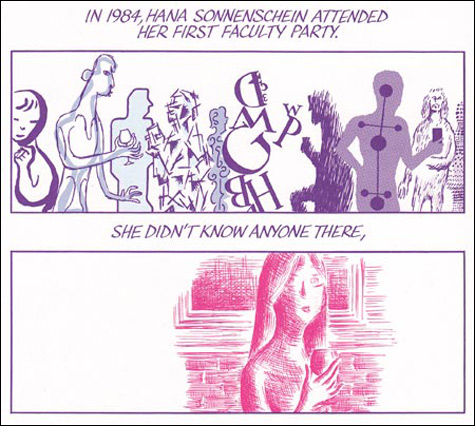
ASTERIOS POLYP David Mazzucchelli’s story of a curmudgeonly Greek-American architect manqué is the veteran artist’s best work yet. |
Comics. Graphic novels. Sequential-art books. Call them what you will, but there are more of them than ever. It’s like craft brewing or wind energy: even in this economy, business is booming. Here’s a rundown on some of the best from the past few months.
My favorite — for its spare, exquisitely expressive æsthetics and its pacing and skillful storytelling — is David Mazzucchelli’s ASTERIOS POLYP (Pantheon). Mazzucchelli has had a long career, in which he’s illustrated both superhero comics (he drew Frank Miller’s classic Batman: Year One) and artier graphic novels. This is his best project yet, as he uses finely rendered ligne claire figures, a meticulously laid-out geometry class of panel shapes, and energetic splashes of candied color to tell the story of a curmudgeonly Greek-American architect manqué as he reinvents his life.
Equally well drawn — but nowhere near as vibrantly hued — is Hannah Berry’s moody debut, the noirish BRITTEN AND BRÜLIGHTLY (Metropolitan). Set in London in the ’40s, the sumptuously shadow-cast narrative follows Britten, a Chandler-esque gumshoe, and his partner — a tea bag, natch — as they traverse rain-glazed streets and paw through overstuffed filing cabinets while sleuthing through a particularly fraught case.
Berry is an abundantly promising beginner; Yoshihiro Tatsumi is a living legend. A manga trailblazer for nearly half a century, he’s known as “the grandfather of Japanese alternative comics,” and his mammoth memoir A DRIFTING LIFE (Drawn & Quarterly) — 849 pages, three pounds — is a sprawling yet intricately detailed limning of his long life and career as a gekiga artist in a nation where comics are as ubiquitous as food.
Speaking of food: Harvard biomedical-engineering professor David Edwards — nom de guerre, Séguier — continues his own interesting twist on manga with WHIFF (Harvard University Press), a sort of hybrid non-fiction/graphic novel that he wrote and Junko Murata illustrated. The story recounts the real-life experiment at Paris’s “artscience center” Le Laboratoire (which Edwards founded), where chef Thierry Marx and scientist Jérôme Bibette set about aerosolizing food, so that delectable comestibles like chocolate can be consumed via inhalation.
That food-delivery method might have been appreciated by Jeffrey Brown, who documents his teenage battle with Crohn’s disease in FUNNY MISSHAPEN BODY (Touchstone). Sporting a self-effacing voice and an unselfsatisfied drawing style, the book also explores his difficult adolescence, his dalliances with drinking and drugging, the awkward art critiques that were made of him, and the five years he spent burning designs into Dutch wooden shoes.
Similarly exploring the personal, even as it telescopes out to the interpersonal and the political, is Josh Neufeld’s A.D.: NEW ORLEANS AFTER THE DELUGE (Pantheon), which recounts seven true stories through the eye of Hurricane Katrina, from the nauseating apprehension of its approach to its anguished, infuriating aftermath. Leavened with doses of humor and a counterintuitive (but effective) cartoonish drawing style, Neufeld’s smartly written book evokes the horrible chaos of the storm — and the human dramas left in its wake.